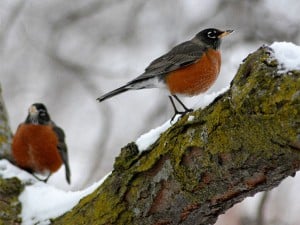Winter robins and songbirds

Robins toughing out the winter. Photo: Jonathan Bloy, Creative Commons, some rights reserved
The arrival of red-breasted robins is generally taken as a sign of spring, something many will be eager to welcome this year. But here’s more for the “I-did-not-know-that” file: some robins stick around, all year. Even in a winter like this one.
I got onto this topic after reading a 2/28 article by the Ottawa Citizen’s science writer, Tom Spears.
The Ottawa Field Naturalists have spotted a winter flock of about 30 robins near the Britannia Woods, and 25 robins — possibly the same group — a couple of kilometres south, on Iris Street.
The trick for the robins is to find food once the frozen ground cuts them off from worms.
Necessity has taught them to fish. In one corner of Mud Lake, in Britannia, there’s a pool of open water most of the winter, fed by underground seepage that keeps it ice-free.
Naturalist Dan Brunton says this supplies the water with oxygen and draws a huge crowd of small lake creatures — minnows, tadpoles, even aquatic insects that stay active all winter.
And robins have learned to stand at the edge of the ice and pick live minnows right out of the water.
Spears has a cute photo of a minnow-catching robin on his twitter account.
Here’s more about the American robin from the Cornell Lab of Ornithology.
Once I started looking, I found lots of similar discussion online about robins that surprised people by staying through the winter. Here’s something written in January from bird columnist Arlene Koch who writes for Lehigh Valley Live in Pennsylvannia, “Not all American robins head south for the winter“:
This week’s column is about American robins because recently I’ve been asked several times why people are seeing robins in their yards. The answer to that question is simple. There are always robins in the Northeast every winter in spite of the fact that seeing one is supposed to be a symbol of spring.
People have been talking about seeing winter robins in Northern Ontario (CTV video report), which mentions that while annual Christmas bird counts prove this happens year in and year out, the numbers of over-wintering robins seen in, say Sudbury, remain small – averaging only one or two counted in any given year.
In the US here’s coverage on winter robins out of New Hampshire, Michigan, Wisconsin (where the birds were observed eating insects near a river), and in the upper mid-west.
The reporting sounds similar because people are struck by the presence of robins in a very cold winter. They get noticed and discussed, as illustrated by this article out of Indiana:
Robins in January in northern Indiana, anywhere in Indiana, or in February are birds to talk about. Two days after I saw the robins in my yard, a friend told me she had recently seen a small flock of robins near her home. Two days later, I stopped at the garage where I have my car serviced, and one of the mechanics asked, “Hey, Neil, what’s with the robins?”
He, too, had recently seen robins. Later that same day when I went in the bank, two men told me they had seen a flock of robins days before.
Todd Moe chatted with naturalist Conner Stedman about bird language and songbirds that stay all winter on Friday morning. This discussion did not involve robins, but included details about other birds we can expect this time of year.
I’d be interested in hearing about what you saw this winter in terms of robins, birds and wildlife in general.
Tags: canada, environment, natural science, Ontario, robins, song birds, spring, weather, winter








Last week we toured the “magic triangle” east of Whallonsburg, NY, near the shores of Lake Champlain and observed flocks of hundreds of robins where the grass was showing in the fields. It was incredible to see so many with snow still on the ground.
Hi! I enjoyed reading your article about winter robins. I see a small flock of robins every winter at Wilson Hill Game Preserve in Louisville NY. I can’t imagine what they eat but they are certainly a welcome sight and sound!
I’ve seen robins in Avalanche pass in February – not sure what they were eating or how long they stayed.